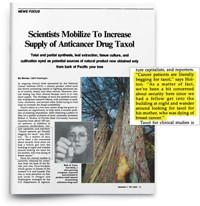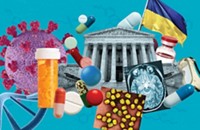Advertisement
Grab your lab coat. Let's get started
Welcome!
Welcome!
Create an account below to get 6 C&EN articles per month, receive newsletters and more - all free.
It seems this is your first time logging in online. Please enter the following information to continue.
As an ACS member you automatically get access to this site. All we need is few more details to create your reading experience.
Not you? Sign in with a different account.
Not you? Sign in with a different account.
ERROR 1
ERROR 1
ERROR 2
ERROR 2
ERROR 2
ERROR 2
ERROR 2
Password and Confirm password must match.
If you have an ACS member number, please enter it here so we can link this account to your membership. (optional)
ERROR 2
ACS values your privacy. By submitting your information, you are gaining access to C&EN and subscribing to our weekly newsletter. We use the information you provide to make your reading experience better, and we will never sell your data to third party members.
Pharmaceuticals
Chemistry And Pharmaceuticals
by Rudy Baum, Editor-in-chief
April 10, 2006
| A version of this story appeared in
Volume 84, Issue 15
This week's issue of C&EN is absolutely packed with a wide variety of stories that capture the breadth and complexity of the chemical enterprise. There are Business Department stories on chemical plant security and challenges faced by the petrochemical industry; a Government & Policy Department story on voluntary guidelines for safely making, transporting, using, and disposing of chemicals; and a Science & Technology Department story on the challenges faced by the editors of scientific journals as they grapple with scientific fraud and other serious ethical violations. There are also a number of stories reporting on papers and symposia at the recent ACS national meeting in Atlanta. (Don't miss the wonderful photo spread from the Atlanta meeting on pages 78-79.)
One thing that struck me as I read the pages of this week's issue was the number of stories that linked chemistry and pharmaceuticals. Of course, as chemists we are acutely aware of the essential role chemists and chemistry play in the discovery and development of new pharmaceuticals. However, the stories in this week's issue bring the intensity of that link into sharp focus.
Start with the cover story on pharmaceutical outsourcing. This is actually three case studies of the relationship between a small drug company and a pharmaceutical chemistry provider.
The theme that ties the case studies together is the powerful synergies that can be achieved by a close and productive relationship between a drug company and pharmaceutical chemical company. For example, Case Study #2, written by Associate Editor Lisa Jarvis, profiles the dash to market for Millennium Pharmaceuticals' cancer drug Velcade. The drug was so effective in Phase II trials, Jarvis writes, "that regulatory authorities were willing to let the drug onto the market before Phase III trials were completed-a year ahead of the company's launch projections."
Millennium turned to Ash Stevens Inc. (ASI), which had been involved with producing small quantities of Velcade's active ingredient, to help get the manufacturing piece of the puzzle in order, Jarvis reports. ASI was able to deliver a better process for producing the drug, even under the accelerated program. That was possible because ASI has been willing to take a risk and sink money into a project years before the drug was slated to come to market.
The lead Business Department story by Hong Kong Bureau Head Jean-Fran??ois Tremblay is an in-depth examination of the controversies surrounding GlaxoSmithKline's antiviral drug Relenza (zanamivir). Relenza is one of two drugs (Roche's Tamiflu is the other) that have shown any promise at all for treating humans who become infected with the H5N1 strain of avian flu. Nations are trying to stockpile large amounts of both drugs in anticipation of the possibility that H5N1 develops into a strain that can be transmitted from human to human and ignites a worldwide pandemic of a potentially fatal flu.
"Controversy has dogged Relenza almost since the product was first approved in 1999 as a treatment for seasonal flu," Tremblay writes. What caught my interest, in particular, was the chemistry involved. Zanamivir is a complex molecule that is very difficult to synthesize from an expensive starting material that is in tight supply.
The lead Science & Technology Department story by Senior Editor Sophie Rovner examines efforts to understand, treat, and ultimately prevent Parkinson's disease, the second most common neurodegenerative disease after Alzheimer's. Because traditional tactics of drug development and testing have failed to turn up a satisfactory Parkinson's treatment, Rovner writes, researchers at the National Institute of Neurological Disorders & Stroke are "changing the rules of engagement." The institute's notion "is to carry out quick clinical studies of promising compounds to see if they don't work" to avoid investing time and effort in things that are useless.
A story from the ACS meeting by Managing Editor Maureen Rouhi looks at the work of William Fenical, a chemistry professor at the University of California, San Diego, and Scripps Institution of Oceanography, who is this year's recipient of the ACS Award in the Chemistry of Natural Products. Fenical's work on natural products from deep-sea bacteria is revealing whole new classes of compounds that exhibit antibiotic and anticancer activity.
These stories capture well chemistry's ongoing seminal contributions to human health and well-being.
Thanks for reading.




Join the conversation
Contact the reporter
Submit a Letter to the Editor for publication
Engage with us on Twitter